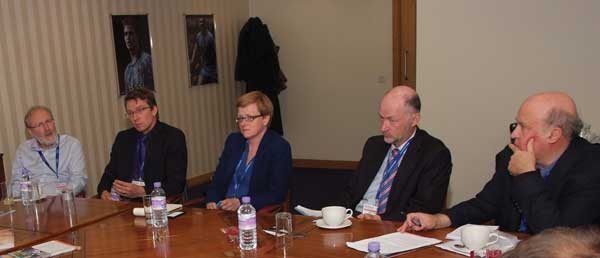The UK photonics industry needs to make connections with the markets it enables if it wants to take advantage of the opportunities available today and grow into an even brighter tomorrow, according to executives speaking at a recent industry event.
Carlos Lee, director general of EPIC, the European Photonics Industry Consortium, moderated an executive round table at a press event organized by ESP KTN in conjunction with the Photonex 2013 conference held in October in Coventry, England. Connection was the main theme of the discussion.
A major connection to be made is to the fields covered by the Catapult Centres named by the UK’s Technology Strategy Board. The Catapults focus on technological innovation in seven specific areas – high-value manufacturing, cell therapy, offshore renewable energy, satellite applications, the connected digital economy, future cities and transport systems – with the goal of driving future economic growth. Each area is clearly enabled by photonics, the executives pointed out.
 From left, Malcolm Varnham of SPI Lasers, John Lincoln of the UK Photonics Leadership Group, Anke Lohmann of ESP KTN, photonics consultant David Gahan and Mark Sims of the University of Leicester offer their perspectives on the UK photonics industry. Courtesy of Photonex.
From left, Malcolm Varnham of SPI Lasers, John Lincoln of the UK Photonics Leadership Group, Anke Lohmann of ESP KTN, photonics consultant David Gahan and Mark Sims of the University of Leicester offer their perspectives on the UK photonics industry. Courtesy of Photonex.
“We need to look at the Catapults as opportunities for photonics,” said John Lincoln, appointed CEO of the UK Photonics Leadership Group (PLG). “If photonics isn’t named a Catapult, photonics people say it’s a tragedy. But photonics supports the Catapults – there’s the opportunity.”
Focus on manufacturing
The UK has historically been strong in manufacturing but shifted focus decades ago to banking; now the government wants to go back and rebalance the economy through a renewed focus on manufacturing.
Photonics is expected to play a role, as it comprises a large number of small companies that anticipate a higher recruitment percentage growth than larger companies. The UK has 1500 photonics companies that employ 70,000 people and produce approximately £10.5 billion in output; that figure makes up about 20 percent of Europe’s total.
The top UK employment areas are optical systems (20 percent), medical (19 percent), production (15 percent) and defense (10 percent). Other strong fields include space, the life sciences, manufacturing (including 3-D advanced manufacturing), and sensing for food, security and gas applications. Those are the markets on which the photonics community must focus, the group agreed.
“[The focus is] not going to change from high-level areas,” Lincoln said. “The critical thing is the connection to photonics, connecting photonics to the high-level areas of the value chain.”
Paradigm shift recommended
The executives spoke frankly about what the UK should do to catch up to the US, Germany and Korea. The model in the US, they say, is largely confidence-based: Companies believe that their products will succeed, so they get funding – and they succeed. In contrast, Germany funds studies and testing through a large system of institutes such as the Fraunhofers, which can generate copious amounts of data that prove future success.
“The European view is bottom-up: Look at what the technology enables,” Lincoln said. The UK has a free-market approach, he added, looking at different areas to see what technology evolves to support them.
“The UK is very nervous about picking winners,” said David Gahan, a photonics industry veteran and currently a consultant.
“The UK is a very modest nation: ‘I’m very sorry, but we make some really excellent lasers,’ ” Lincoln joked, adding that companies from other countries – Coherent and Trumpf, to name two – actually come to the UK to build or buy facilities.
The round-table participants had specific advice to help the UK photonics industry become an even stronger force in photonics. Gahan urged the UK TSB (Technology Strategy Board) to “provide follow-on funding into the higher levels of TRL 6-7 (Technology Readiness Level) to support demonstrators.” Research councils sponsor early TRL levels, and industry funds later TRL levels, so there’s a TRL gap, said Mark Sims, professor at the Space Research Centre of the University of Leicester. “There’s more ideas out there than funding,” he added.
Malcolm Varnham, vice president of intellectual property and a co-founder of SPI Lasers, called for greater emphasis on education and training, especially for technicians and operators.
Anke Lohmann, director of photonics at the UK government agency ESP KTN (Electronics, Sensors, Photonics Knowledge Transfer Network), encouraged industry engagement and collaboration between companies to address specific needs. “The industry must be more open. US companies are more open – they talk about what they do.”
Sims urged companies to make connections to underpinning technologies. He also asked for the UK science budget to be increased as soon as possible.
“By keeping it flat, it is being eroded by inflation – putting at risk the UK’s capability for medium- and long-term growth,” Sims said.